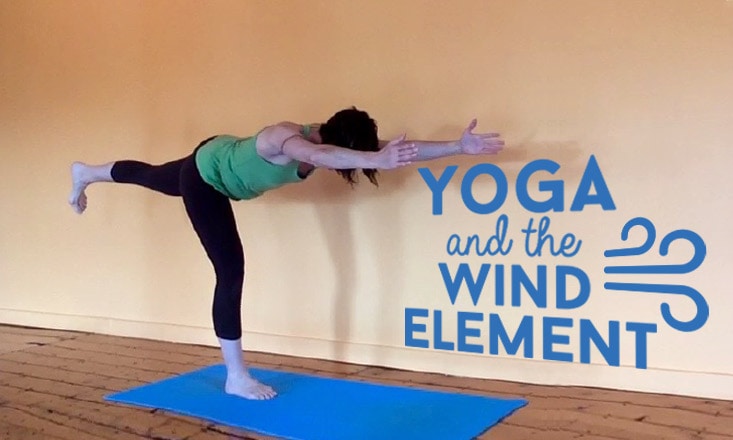Whether you prefer a practice that moves quickly through a sequence, or one that focuses more on stillness, a good yoga session connects you with a deep sense of rhythm. Repeatedly emphasizing that sense of rhythm, soothes and nourishes wind element in the body.
Wind Element and Ayurveda
According to Ayurveda, wind element (sometimes called air) powers all movements; from the action of your joints to the passage of nutrients through cell walls. You can feel the qualities of wind element in the cold wind of autumn and winter: cold, dry, rough, irregular, unstable (moving) subtle and light.
 Wind element yantra by Susan Fauman
Wind element yantra by Susan FaumanBecause wind is movement, it is also power. Undistorted wind element gives you great, unforced capacity for work, great stamina, and enthusiasm for life. The subtle nature of wind element conveys inspiration and creativity.
Healthy wind means all movements and cycles in your body occur with regular rhythm and timeliness. There are neither excess movements in the intestines (rumbling, gas and bloating), nor trembling sensations or spasms in the muscles. Sleep comes easily and is undisturbed through the night, and you handle life’s difficulties without anxiety or excess stress.
However, the habits of over-doing, multi-tasking and spending long hours in front of a computer can badly disturb wind element, causing anxiety, insomnia, severe depletion, constipation, and joint pain among other complaints.
Wind Element Sequence:
In my last three posts, I offered poses for connecting with earth, water, and fire elements. The sequence below could be used on its own or mixed in with the other postures to create a sequence which awakens earth, water, fire, and wind — invoking a sense of balance between rootedness, transformation, and growth.
Emphasizing deep, full breathing will take this practice to the next level. Here are 4 poses for connecting with wind element:
Cat Pose (Marjaryasana)


Inhale and come back to the arch position. Try to make the length of the breath and movement match up.
Continue this movement until your motion is fluid and your spine feels supple and awake.
Benefits: This popular posture is great for syncing your breath and movement. It also enhances the circulation of cerebral-spinal fluid and encourages proper movement of the pelvis for forward and back bends.
Warrior III (Virabhadrasana III)

Inhale and lift your arms alongside your head and exhale, hinging forward on the right hip, keeping the torso in line with the left leg. Only come forward as far as you can without lifting the left hip upwards.
On the next inhalation, hinge back up to standing, but try not to touch your left foot down to the mat. Exhale hinge forward again.
Continue hinging up and down with each breath for 3-5 repetitions. On the last repetition, hold the balance for 5-10 breaths before returning to standing on an inhalation.
Benefits: Balance postures in general have a great, rooting effect on wind element if they are practiced with a light heart. That means going easy on yourself if you can’t stick the balance. Falling out of the posture laughing is much more effective than deepening your frown lines as you hold your breath and nail the shape of the pose.
Pendulum Pose (Dolasana)

The exhalation will come out in 3 parts. Make a “HA!” sound with each part.

2. Bounce slightly, and bring the chest towards the right leg.
3. Bounce again and bring the chest towards the left leg.
Inhale deeply as you lift the torso back up to standing.
Repeat 4-8 times. Avoid this posture if you have high blood pressure or glaucoma. If you feel dizzy, come to a squat or Child’s Pose until it passes. Also, if you have very tight hamstrings, bend your knees slightly.
Benefits: This pose is amazing for releasing tension around your voice, or “speaking your truth.” It also helps to release the weight of grief from the heart and chest.
Reverse Savasana (Advasana)

Breathe deeply into your belly and relax. Stay here as long as you feel comfortable.
Benefits: This variation of Savasana helps to reduce stimulation and quiet the mind. It also causes the inhalation to expand into the lower back, helping to release tension and inflammation there.
What are some of the ways you find rhythm and rootedness in your practice? Try these poses out — especially the ones that are new to you — and let us know: can you feel the power in clarified wind element?


